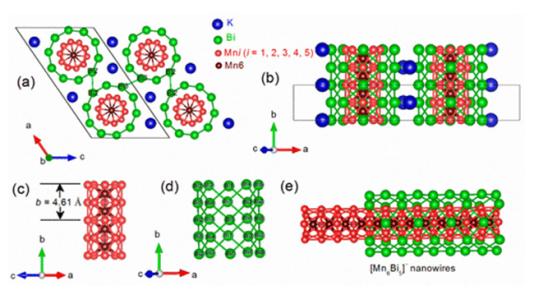
Scientific Achievement
We synthesized a unique antiferromagnetic metal KMn6Bi5 that contains naturally formed [Mn6Bi5]- nanowires. The nanowires have a five-fold rotation symmetry with Bi atom sheathing and a vertex-sharing Mn13 icosahedra cluster-based core.
Significance and Impact
KMn6Bi5 exhibits 1D-to-3D transitions in electronic transport and magnetism, providing a platform to study the link between magnetism, carrier and dimensionality. The small magnetic moment of Mn makes KMn6Bi5 a promising system to search for superconductivity.
Research Details
- The structure of KMn6Bi5 was solved by single x-ray diffraction and further resolved by high resolution TEM.
- Magnetization, and anisotropic resistivity measurements prove an antiferromagnetic order at ~75 K and quasi-one-dimensional nature of magnetism and transport property.
DOI: 10.1021/jacs.8b00465
Argonne National Laboratory seeks solutions to pressing national problems in science and technology. The nation’s first national laboratory, Argonne conducts leading-edge basic and applied scientific research in virtually every scientific discipline. Argonne researchers work closely with researchers from hundreds of companies, universities, and federal, state and municipal agencies to help them solve their specific problems, advance America’s scientific leadership and prepare the nation for a better future. With employees from more than 60 nations, Argonne is managed by UChicago Argonne, LLC for the U.S. Department of Energy’s Office of Science.
The U.S. Department of Energy’s Office of Science is the single largest supporter of basic research in the physical sciences in the United States and is working to address some of the most pressing challenges of our time. For more information, visit https://energy.gov/science.